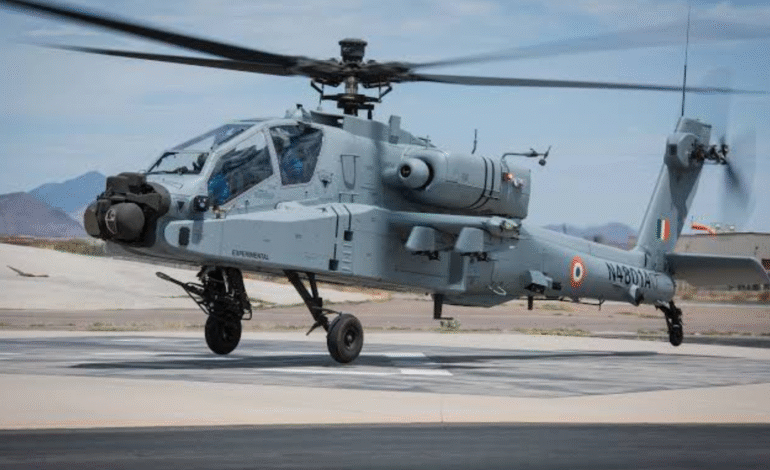Apache Helicopters in India: Strengthening Border Readiness and Air Power

India is poised to bolster its aerial defense capabilities with the scheduled arrival of U.S.-made AH‑64E Apache attack helicopters on July 21 a development that has occurred more than a decade after the initial procurement deal. The helicopters, often referred to as “tanks in the sky,” are set to be stationed at the Indian Air Force’s Hindon Air Force Station, lending critical support to India’s posture along the Pakistan border.
In Apache History & Strategic Relevance
The roots of India’s Apache program trace back to a 2015 Boeing–U.S. government deal for 22 AH‑64E helicopters, with all deliveries completed by July 2020. In addition, during President Donald Trump’s 2020 visit to India, a subsequent deal worth $600 million called for six more helicopters. Procurement delays driven by global supply-chain disruptions, geopolitical shifts, and industrial constraints including reliance on Tata Boeing Aerospace in Hyderabad meant the first three of the six were only delivered in 2023.
Now, nearly 15 months since the activation of its first army Apache squadron in Jodhpur, India is expecting another milestone: the deployment of the next consignment directly to IAF’s strategic base at Hindon, closer to the sensitive Punjab-Pakistan frontier. Notably, India already operates two active IAF Apache squadrons one at Pathankot in Punjab and another at Jorhat in Assam.
Why These Apaches Matter: Capabilities & Combat Value
The AH‑64E, the latest and most advanced Apache variant, is engineered for the modern battlefield. Its title “tanks in the sky” stems from its robust armament: AGM-114 Hellfire missiles, 70 mm rocket pods, and a 30 mm M230 chain gun. It also features advanced sensors, networked targeting capabilities, and the ability to lock onto ground and low-altitude air threats making it a potent deterrent across land, sea, and air. According to Boeing, the aircraft is optimized for multi-domain operations, making it ideal for India’s evolving threat landscape.
The Strategic Landscape: Why Now, Why Here?
Deploying Apaches to Hindon within striking distance of the Pakistan border underscores India’s current strategic imperative. Elevated border tensions, increased terrorist activity, and the need for rapid response platforms have made helicopter-based firepower a high priority. Apaches supply long-range firepower, overwatch surveillance, quick-reaction strike capability, and psychological deterrence — all pivotal for border defense.
According to defense insiders cited in NDTV and News18, this Apache deployment is part of a broader modernization roadmap. Plans include increasing squadron sizes, adding Unmanned Aerial Systems (UAS), and enhancing ground-based defenses. Integrating the Apache into existing IAF squadrons paves the way for a network-centric battlefield, enabling real-time data sharing and mission coordination.
Behind the Scenes: Industrial Base & Supply Challenges
The procurement’s extended timeline stems partly from global supply chain issues from chip shortages to COVID-19 disruptions. But a more localized challenge was ramping up domestic production through Tata Boeing Aerospace in Hyderabad. India’s “Make in India” imperative faced hurdles in quality control, project delays, and scaling. The first local Apache shell was only delivered in 2023, underscoring India’s development curve. This consignment reflects both technological progress and a growing domestic defense industry.
Future Outlook: Building a Modernized Air Force
With the July 21 arrival, India’s stock of AH‑64Es will rise to nine enough to expand existing squadrons and potentially add a third. This fits into the IAF’s roadmap to strengthen its combat helicopter fleet. Beyond Apache upgrades, the IAF has advanced deals underway for Sikorsky S-70B Seahawks, Kamov Ka-226T utility helicopters, and Harbin Z-19E light attack helicopters which diversify India’s air capabilities.
Anchor for UAE & Middle East Audiences
Despite being centered in South Asia, India’s Apache deployment carries resonance for GCC defense discourse due to shared security dynamics. Many regional air forces, including UAE’s, operate Apaches and engage with India on joint training and maintenance. India’s progress strengthens regional cooperation in air safety, multilateral exercises, and military R&D partnerships between India, Gulf nations, and the U.S.
India’s upcoming Apache helicopter deployment on July 21 is a significant leap forward, signifying an enhanced aerial deterrence capability along the Pakistan border. It reflects India’s evolving defense posture, emerging industrial proficiency, and ambition to operate a 21st-century, multi-domain air force. For observers in the UAE and the Middle East, this represents one more chapter in a region’s shared evolution towards advanced aerial defense systems and strategic cooperation.







